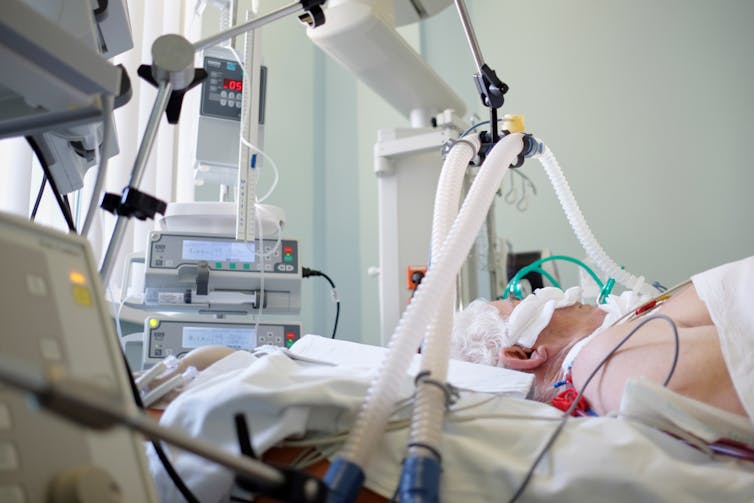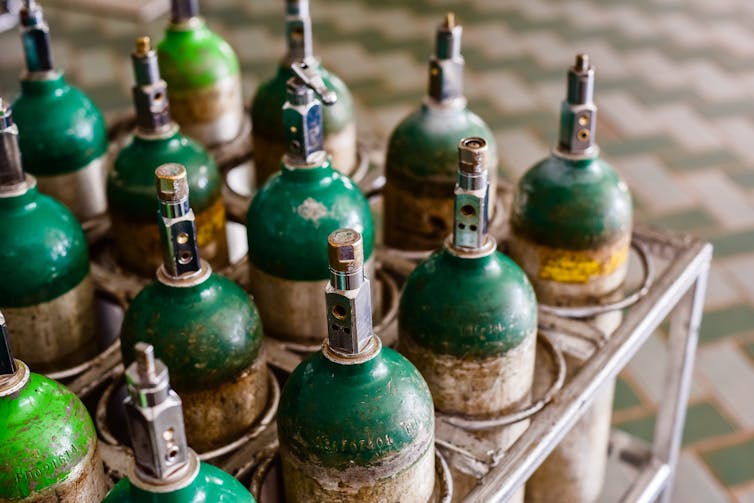We know a lot about the symptoms of severe COVID-19, but relatively little about what happens after someone recovers. Could there be long-term effects? Let’s look at what we know so far about the effect of COVID-19 on the body – particularly the lungs – and the potential for lasting damage.
The lungs are the organ most commonly affected by COVID-19, with a spectrum of severe effects. One is pneumonia, where inflammation causes the small air sacs that make up the lung to fill with fluid. In COVID-19, pneumonia tends to affect both lungs. If large parts of the lungs are affected, people struggle to absorb enough oxygen and are admitted to hospital.
Another severe effect is acute respiratory distress syndrome (ARDS) – also known as “wet lung”. This sees severe inflammation spread quickly throughout the lungs. People who develop this may need mechanical ventilation in an intensive care unit, sometimes for a prolonged period.
COVID-19 has a further, unusual effect on the body. Compared to other respiratory viruses, it causes marked clotting in the small blood vessels of the lungs and other organs.
How the Virus Damages the Lungs
Although the lungs can recover from severe COVID-19, they can also sustain longer-term damage of varying severity.
The SARS-CoV-2 virus enters the cells of the airway through the angiotensin-converting enzyme 2 (ACE2) receptor, a molecule that connects the inside of our cells to the outside via the cell membrane. When this happens, some people react to the virus’s presence by producing an intense immune response, known as a “cytokine storm”, along with increased blood clotting, all of which leads to damage to lung cells.

The body replaces cells damaged by the virus with scar tissue, which is thick and stiff. This can result in a condition called “pulmonary fibrosis”, which has been seen in people with COVID-19 and is probably more likely to develop if the lungs are severely affected by the infection. The condition can make people breathless doing activities that they would usually manage without difficulty. Drugs that reduce scarring may have a role in preventing it.
We don’t yet know what the impact of pulmonary fibrosis is after infection, but it may lead to long-term symptoms and a progressive fall in lung function. That’s why it’s important to watch out for the condition in people who suffer from severe COVID-19.
However, we can look at other coronaviruses – severe acute respiratory syndrome (Sars) and Middle East respiratory syndrome (Mers) – to try to predict long-term outcomes.
We know that Sars can cause pulmonary fibrosis, and a large analysis of Sars and Mers patients showed weakened lung function and exercise capability in some survivors up to six months after hospital discharge. However, a 15-year follow-up of patients showed improvement in lung function and less damage visible on CT scans over time. An early study of people recovering from COVID-19 found that such damage also improves in the first few weeks after discharge from hospital.
What About Other Organs?
COVID-19 may also cause illness in other parts of the body, ranging from several weeks of non-specific symptoms to impairment of the kidneys, heart, gastrointestinal tract, nervous system and clotting system. Some effects could be partly caused by clots forming in the small blood vessels supplying these organs. There’s also likely to be an impact on mental health.
Just as important is the impact on a person’s general fitness. People needing mechanical ventilation for a long time lose a significant degree of muscle mass, leaving them weak even after their lungs have recovered.
People with limited reserves to begin with (such as older people) can become deconditioned even after “mild” COVID-19. This may reduce their ability to live independently, so it has important implications for demand on rehabilitation and social care services.

We are still only six months beyond the first emergence of COVID-19, so it’s too early to tell what the extent of any long-term impacts will be. There are still many questions. Who is most at risk of long-term effects following COVID-19? And what could prevent these? COVIDENCE UK is a research study looking at these questions, and is recruiting adults who both have and haven’t had COVID-19 to try to find answers.
While the vast majority who contract COVID-19 will make a full recovery, we’re likely to see more people with pulmonary fibrosis or persistent lung damage following ARDS caused by COVID-19. Many will be severely debilitated for some time following severe infection, and some will need home oxygen. Meeting such people’s longer-term health and care needs will pose a significant challenge.
ABOUT THE AUTHORS
Shanya Sivakumaran, Clinical Research Fellow in Respiratory Medicine, Swansea University; Gwyneth Davies, Professor of Respiratory Medicine, Swansea University, and Mohammad Al Sallakh, Research Officer in Asthma, Swansea University. This article is courtesy of The Conversation.



